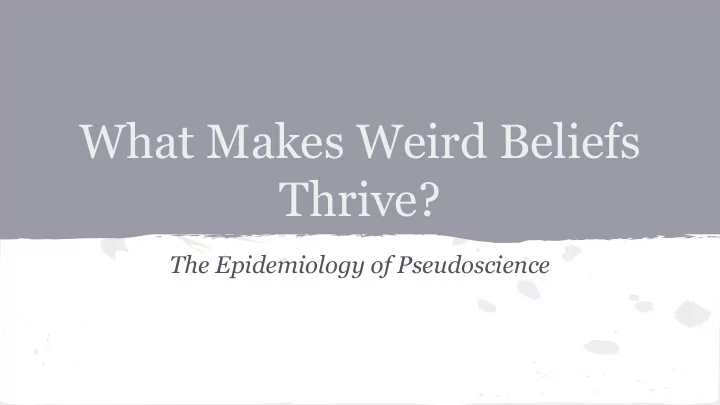

What Makes Weird Beliefs Thrive? The Epidemiology of Pseudoscience
Goal ● Cultural dynamics of pseudoscience (vs. science) ○ symptoms? ● Setting the stage ○ demarcation problem ○ intuitive appeal of pseudoscience ○ immunizing strategies & defense mechanisms
Demarcation problem ● old chestnut in philosophy ● traditional approach ○ silver bullet ○ formal distinction ● logical relation between ○ propositions ○ observation statements ● reluctant to bring science down to earth ○ psychology, sociology, cognitive science...
Naturalizing Science ● not abstract & disembodied ● natural phenomenon ○ cognitive underpinnings ○ social organization ○ institutional structure ● evolves over time… ○ theory choice / theory development
Cultural evolution ● what is distinctive about science? ● contrast it with its contenders ○ fake & phoney science ○ mimicry of the real thing ● Evolutionary dynamics
Epidemiology of science ● Scientific representations ○ highly counterintuitive (McCauley 2011, Wolpert 1992) ○ Epistemic selection (in the long run) ● institutional structures ( peer review, open access…) ● methodological principles ( double-blind trials, statistical testing…) ■ cultural disadvantage
Stability over time ● Cultural stability ○ in scientific community ○ in population at large ● stability ○ institutional support ○ prestige ○ technological success ● without those crutches… ○ collapse of science
Pseudoscience ● Mimics the trappings of science ● epistemic selection? ○ absent or inconsequential ■ (not cheating!) ● gravitation towards intuitive representations ○ at the expense of epistemic integrity ○ examples: essentialism, teleology, sympathetic magic, intentional stance, intuitive physics... ■ see paper…
Cultural success imperiled Pseudoscience ● clashes with reality ● lack of psychological validation
The Pull of Reason ● humans are not impervious to reason ○ we care about truth (Kunda 1990; Mercier and Sperber 2011) ● objections and empirical failures pose a threat to the belief system ○ nobody will embrace beliefs that are obviously false ○ scientific pretensions ■ keep up appearances
Mimicry How to mimic good science? ● Epistemic warrant is hard to fake ● Immunizing strategies & defense mechanisms ○ Explored elsewhere (Boudry & Braeckman 2011,2012)
Examples ● multiple endpoints in prediction ● conspiracy theorizing ● built-in ad hoc clauses ● theory-internal explanations for dissent and resistance ● methodological licenses → facilitating (spurious) confirmation, avoiding refutation
Back to the demarcation problem ● No silver bullet ○ specific features of the theory ○ behavior of its adherents ○ social organization ● Requires detailed examination ○ instead: look at large-scale effects ○ how does this play out on a cultural level?
Paradox ● Pseudoscience ○ Protection from external threats ○ Tapping into sources of psychological validation → Liable to internal disruptions → Culturally unstable
Cultural evolution ● Success of pseudoscience ○ structural features ○ room for variation in the content ● Cultural change ○ conceptual innovation ○ may not affect its ‘fitness’ ● Cultural drift ○ in the absence of epistemic selection
Empty shell ● changing the content of the belief ○ leaves the cultural ‘fitness’ intact ○ no rational method to settle disputes
Cultural changes 1. Different themes (variation) 2. Reduction (simpler theory) 3. Elaboration (more complex theory) 4. Recursion (new layer)
1. Different themes ● play a different tune ○ spin off rival factions, conflicting theories ■ “centrifugal dynamic” of psychoanalysis (Crews 1986) ■ “balkanization” of Velikovsky’s theories (Gordin 2012) ● Victim of its own success ○ too easy to play a different tune
Theoretical disputes ● Irresolvable disputes ○ little epistemic constraints ● Achieving stability? ○ authoritarian force ○ protection of dogma ○ ostracizing of dissidents ○ focus on founding texts
2. Reductions ● Reduction of elements in belief system ○ alternative medicine “that which is thought by the healer to be the cure is eventually eliminated—with no reduction in effectiveness” (Park 2002, p. 62) ○ disappear in the absence of selection pressure ■ animal magnetism (special gadgets) ■ homeopathic dilutions (potentializing)
3. Elaboration ● introduction of new elements ○ equally successful ● For example: ○ extra “meridians” in acupuncture ○ new constellations in astrology ○ new applications (inflated ambitions)
4. Recursion ● conspirational reasoning ○ conspiracy theories, psychoanalysis, Scientology, reincarnation therapy ○ additional layers ● Spirals of suspicion ○ theory turning in on itself ● Rhetoric of conspiratorial thinking ○ the truth is out there ○ reaching the bottom
Conspiracy theories ● What if there is another level of cover-up? → upping up the ante
9/11 conspiracy theories ● 9/11 was an inside job ○ “no plane hypothesis” ○ reductio ad absurdum? ● mutual accusations shrinking away from the full ○ truth? ○ complicit in the cover-up damaging the cause ○ disseminated by government? ○
Belief systems ● The very features that allow them to survive critical scrutiny… ○ immunizing tactics ○ psychological appeal ○ recipes for spurious validation ...make them victims of their own success
Conclusions (1) ● Demarcation problem is not dead ○ no silver bullet ○ mimicry & imitation ● Science vs. Pseudoscience ○ Symptoms ○ Cultural dynamics ○ How do they develop?
Conclusions (2) ● Resilience of pseudoscience ● Internal instability ○ changing the theme ○ elaboration ○ reduction ○ recursion Boudry, M., Blancke S. & Pigliucci M. (2014) “What Makes Weird Beliefs Thrive? The Epidemiology of Pseudoscience”, Philosophical Psychology
Recommend
More recommend